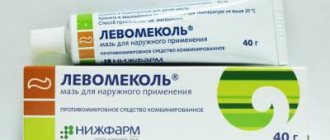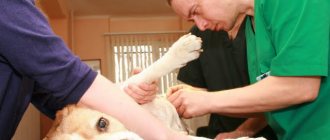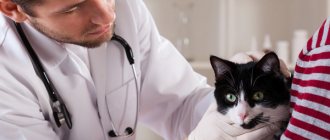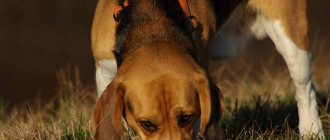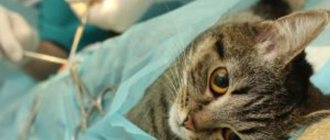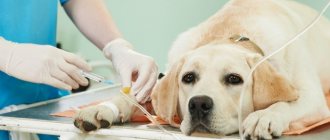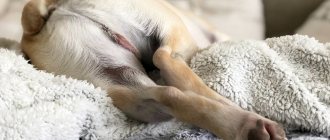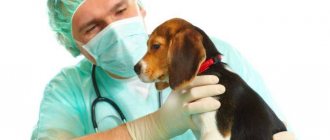General rules for caring for your dog after surgery
The main rule is to strictly follow all the recommendations of the specialist who performed the operation on the pet. Do not make your own adjustments to the advice given. Otherwise, it will end badly for the dog itself. If the doctor’s words make you doubt the benefits for your pet, then do not look for a solution to the problem on the Internet. Consult another veterinarian. Based on the tests and the general condition of the dog, he will prescribe suitable medications and give an expert assessment of the current situation. But there are also general rules of care that will help your pet recover after surgery.
Rehabilitation period
It is a mistake to believe that the dog will become as active a day after surgery as it was before surgery. As a rule, the rehabilitation period takes about two weeks. The more complex the operation and the more serious the intervention, the longer the pet will have to recover. Much depends on his age. Older animals, like older people, take significantly longer to fully recover.
Your young pet quickly began to delight you with his active behavior and does not show any deviations from his usual lifestyle - this is not a reason to refuse the prescribed recommendations of a specialist. If the veterinarian has prescribed two weeks of “bed rest” for the dog, the owner must adhere to this rule.
Walks
During the rehabilitation period, the dog is given more rest. She also won’t want to ask to go outside when she needs to, because the pet won’t eat before or after the operation. It’s better to wait out the first 24 hours and then give him a little freedom. This doesn't mean walking should be limited to five-minute sessions. You can walk for quite a long time. The main thing is to avoid physical activity. In the first days after surgery, the suture is very vulnerable and can easily come apart. To prevent this, walks should be easy. Avoid places where dog groups gather, so that the pet does not decide to start a game with them, thereby causing harm to itself.
The number of walks directly depends on the medications the dog receives after surgery. If we are talking about medications that have a diuretic effect, the pet is taken outside several times a day. The dog must not be allowed to endure. This will not have the best effect on her general condition and will delay the moment of complete recovery after surgery.
What to feed your dog after surgery
It is also important to understand what to feed your dog after surgery. To avoid doing anything stupid, strictly follow the recommendations prescribed by the veterinarian. Even if the new diet turns out to be troublesome, be patient, as this will help your pet recover much faster.
Nutrition is determined individually and depends on the operation the dog has undergone. But there are general rules on how to feed an animal during the rehabilitation period. Don't rush to feed your dog. It's better to wait a few hours. Moreover, this applies to those cases where the operation was serious and the animal had to undergo complex anesthesia.
Important! You need to feed in small portions, but often - about 3-4 times a day. It is important that the food is easily digestible and does not overload the stomach. When a dog eats dry food, it must first be soaked a little in warm water. This will make the digestion process several times easier.
If the pet’s diet consists of natural food, then during the rehabilitation period it includes light broths. After a few days, canned food, low-fat cottage cheese or kefir are added, provided that this does not contradict the veterinarian’s recommendations.
It is very important to provide your dog with free access to clean water. If the animal cannot approach the bowl on its own, give it water using a regular syringe. It is important to prevent dehydration. It is worth returning the dog to its usual diet gradually. You need to gradually add regular food to the products recommended by the specialist, increasing its portions each time.
If disturbances in your pet’s digestive system begin to be observed, do not make any attempts to eliminate the problem yourself. It is strictly prohibited to give the animal any medications without prior consultation with a specialist.
Caring for seams - practical instructions for use
Sutures after surgery must be treated in any case, because it is imperative to avoid infection, which can lead to serious consequences. What needs to be done?
- You should carefully examine the postoperative wound at least once a day. It should look clean and not inflamed in appearance. Since the regeneration process is ongoing, the wound may still be reddish and hot to the touch. The presence of pus on the wound should alert you;
- To treat the surface, you must use antiseptic liquids, such as chlorhexidine or hydrogen peroxide;
- Often a cat or dog begins to show attention to the wound, trying to bite or lick it. In such cases, you can put a protective collar or post-operative blanket on it. This will allow you not to disturb the wound and speed up its healing;
- You need to carefully monitor the place where the animal lives. The litter must be dry and clean and must be changed once a day.
You should also try to limit the animal’s movement. You should not let him run or play with other pets.
Narcosis and its consequences
Anesthesia is undoubtedly a very large burden on the animal’s body. It is simply impossible to predict how a pet will behave after such an operation. The reaction of the dog’s body will determine the severity of rehabilitation therapy. Considering the pain of the entire procedure, loss of blood, and sometimes large wounds, you begin to understand that your four-legged friend really has a hard time.
The most dangerous moment is when your pet comes out of anesthesia. As a rule, this happens in a veterinary clinic. Don't rush home. It is better to wait so that, if anything, the animal receives specialized assistance.
Transport your dog home carefully. It is advisable to wrap it in a warm blanket and also avoid unnecessary vibrations. Do not use air conditioning or open windows. This will protect the still vulnerable pet from drafts.
The first day after surgery, recovery from anesthesia
After the owner takes the pet home, he is responsible for the dog’s recovery after surgery. Now he carefully monitors how the animal behaves. On the first day after surgery, follow these rules:
- Provide the animal with absolute rest. Explain to small children (if you have any) that it is better not to touch the dog now or to allocate a separate room for the animal;
- Avoid walking and feeding;
- Make sure the temperature is comfortable for the dog. If necessary, cover her with a blanket. This will not only warm her up, but also prevent hypothermia of the sore spot.
First week after surgery
The first week of a dog’s rehabilitation after surgery can be the most difficult for both the owner and the animal itself. These days, it is extremely important to provide maximum comfort for your beloved pet.
| Day of the week | Pet care |
| 1 day | Be prepared for the fact that it may be quite difficult for your animal to recover from anesthesia. Lethargy or an uneven gait is normal. In some cases, the pet experiences hallucinations. On the first day the dog is not disturbed. If she does not drink on her own, she needs help with this. If it is clear that your pet is very tired from painful sensations, contact a specialist who will select the right painkiller. |
| Day 2 | On the second day the animal should feel better. It's time to start feeding him. It is important to stick to the established diet and keep portions small. Be prepared that your pet may vomit while eating. After the operation, the stomach and the entire digestive system have not yet had time to recover, so there is no need to overload them with heavy foods. Pay attention to a comfortable temperature for the dog so that it does not freeze. Use warm blankets or heating pads. |
| Day 3 | On the third day, the pet will become active. If he asks to go for a walk, don't refuse. The main thing is to avoid strenuous physical activity. If your dog has not gone to the toilet before this point, consult a specialist. Perhaps he will recommend you to give an enema or other special medications, which will contribute to the desire to relieve yourself. It is also recommended to measure the animal’s temperature in the first days after surgery. If the readings are higher than normal, antibiotics may be required. They are prescribed by a veterinarian. |
| 4 day | As a rule, on the 4th day of the rehabilitation period the dog will feel excellent, have an excellent appetite and be highly active. |
| 5 day | The pet is increasingly returning to its usual lifestyle. You will notice that the wounds begin to scar, and the swelling in the suture area has almost completely disappeared, but it is too early to allow heavy stress for the animal. You need to allow him to frolic less, and also make sure that the dog does not lick the cut site. |
| Day 6 | There are practically no external signs that the pet has recently undergone a complex operation. On the sixth day there should be no problems with the animal’s activity, appetite and toilet. |
| Day 7 | The wounds will heal well, and the inflammation in the cut area will completely go away, but it will be too early to remove the stitches. Even after a week, monitor your dog’s mobility. Otherwise, there is a risk that the seams will come apart. |
Postoperative drug support
To make it easier for your pet to bear the consequences of the operation, he is prescribed medicinal support. Special medications help relieve pain, as well as eliminate the unpleasant consequences that arise from them. You should not use this or that drug without permission. A consultation with a specialist who will draw up a treatment program is necessary. Typically, three types of drugs are prescribed:
- Analgesics (painkillers);
- Antibiotics;
- Droppers.
Each different type of medication has a different function. Let's take a closer look.
Painkillers
Usually animals easily tolerate pain, but sometimes such unpleasant sensations are so strong that it leads to shock and loss of consciousness. To ease the suffering of your beloved pet, painkillers are used. The veterinarian can prescribe both injections (Meloxicam, Rimadyl, Travmatin) and medications that are prescribed with food or water (Tolfedin and others).
Antibacterial drugs
They are prescribed to avoid inflammation and other complications after surgery. If the necessary measures are not taken in time, another surgical intervention may be required. It is important to use the medications prescribed by the veterinarian. For them to really work, it is important to follow a strict injection schedule.
Droppers
If the animal is quite weak, which can be caused by a provoked illness or age, the veterinarian will prescribe special drips. Their function is to support the animal’s body and its individual organs, which received the greatest load during surgery.
Seam processing
Often, the suture is removed one and a half to two weeks after the operation. A young and healthy pet may require this procedure earlier. Until this point, it is important to ensure proper care of the seam. Otherwise, complications are inevitable. The seams are processed every day 1-2 times. I am glad that such procedures do not cause any discomfort to the animals. And many dogs are truly delighted by this, thinking that the owner has expressed a desire to scratch his beloved pet’s tummy.
To prevent your dog from licking the cut site, use a special blanket or collar. The seam is treated with a solution of hydrogen peroxide and various wound healing ointments. In case of complications and rotting of the suture, drainage is required to drain the pus. This is what the veterinarian does. He will also prescribe special medications that will help the animal recover faster.
What should you be wary of?
The risk that certain complications may arise after surgery cannot be ruled out. It is important to immediately contact a specialist if the following points begin to be observed:
- Blood streaks appear in the urine;
- Rotting of the seam;
- The dog cannot relieve itself for several days after the operation;
- Increased body temperature of the animal;
- Severe digestive disorder.
Possible postoperative complications
Sometimes the rehabilitation of a dog after surgery is accompanied by some complications. And the owner must be prepared for this. They are expressed as follows:
- Deviation from normal temperature indicators. In the first days after surgery, the owner must measure the pet’s temperature. If the indicator is below the normal level, you urgently need to wrap the animal in a warm blanket or use heating pads. The temperature is high, you need to urgently seek advice from a veterinarian. He will prescribe an antibiotic. It is strictly prohibited to inject any medications on your own;
- Internal bleeding. Blood has begun to ooze from the seam, and the animal has pale mucous membranes; you need to urgently contact a veterinary clinic. All of the above are signs of internal bleeding. If suspicions are confirmed, another surgical intervention will be required;
- Severe swelling of the suture or the appearance of a “bump”. This may go away on its own in a few days, but it is possible that it is an abscess. The surgeon will help;
- The seam began to rot. This problem occurs due to bacterial infection. If the medications prescribed by the veterinarian do not help cope with the problem, it’s time to contact the clinic. You may have to drain the pus and stitch the wound again;
- Cramping or swelling in the neck and muzzle. They indicate an allergic reaction of the animal’s body to a particular drug. It is important to immediately contact a veterinarian, who will make the necessary adjustments to the treatment plan and prescribe medications to eliminate allergic manifestations;
- Involuntary urination. Typically occurs after sterilization or due to infection. The problem can be eliminated both with medication and with surgical intervention.
Experts note that the first three days of the rehabilitation period after surgery are the most difficult for both the pet and its owner. It is on these days that the risk of various complications is extremely high. If everything goes well, the dog will quickly begin to return to its previous lifestyle, demonstrating activity and good spirits.
Operations for dogs at the Biryulevsky Veterinary Center
Our clinic performs a wide variety of operations on animals. We have a qualified team of doctors, we carry out diagnostics, laboratory tests and preparation for operations using high-quality, high-precision equipment. At your request, we are ready to treat postoperative sutures on your dog. You can make an appointment with a veterinarian by calling the numbers listed on the main page or using the online appointment form.
APPOINTMENT WITH A VETERINARIAN
You can view the list of operations performed by doctors at the Biryulevsky Veterinary Center at the link
